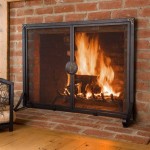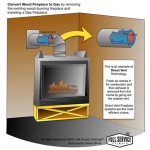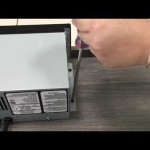Replacing a Gas Fireplace Thermocouple: A Comprehensive Guide
A gas fireplace provides warmth and ambiance, serving as a focal point in many homes. However, like any appliance using gas, it requires regular maintenance and occasional repairs. One common issue that homeowners may encounter is a malfunctioning thermocouple. The thermocouple is a crucial safety component, and understanding its function and how to replace it is essential for maintaining the safe operation of a gas fireplace.
This article offers a detailed guide to replacing a gas fireplace thermocouple, covering the role of the thermocouple, identifying a faulty one, the tools and materials required, and a step-by-step process for replacement. Safety precautions are emphasized throughout to ensure the process is conducted responsibly.
Understanding the Thermocouple
The thermocouple is a safety device used in gas appliances, including fireplaces, water heaters, and furnaces. Its primary function is to ensure that gas only flows to the pilot light or main burner when a flame is present. This is accomplished through a thermoelectric effect. The thermocouple consists of two dissimilar metal wires joined at one end, which is placed in the path of the pilot flame.
When the pilot flame heats the junction of these two metals, a small voltage (millivolts) is generated. This voltage is sent to the gas valve, which then allows gas to flow. If the pilot light goes out, the thermocouple cools down, the voltage drops, and the gas valve closes, preventing gas from leaking into the home. This fail-safe mechanism is vital for preventing gas build-up and potential explosions or carbon monoxide poisoning.
The specific voltage generated by a thermocouple varies depending on the design and manufacturer, but it's generally within a narrow range. A healthy thermocouple should produce a consistent voltage when heated by the pilot flame. A weak or faulty thermocouple may produce insufficient voltage, leading to the gas valve closing even when the pilot flame is present. This results in the pilot light repeatedly going out, a common symptom of a thermocouple problem.
Several factors can contribute to thermocouple failure. Over time, the metal wires can corrode or become damaged from constant exposure to heat. Soot or debris can accumulate on the thermocouple, interfering with its ability to sense the flame and generate voltage. In some cases, the internal connections within the thermocouple can weaken, leading to inconsistent voltage output.
Identifying a Faulty Thermocouple
The most common symptom of a faulty thermocouple is a pilot light that refuses to stay lit. The pilot flame may ignite briefly but extinguishes as soon as the pilot button or knob is released. This occurs because the thermocouple is not generating enough voltage to keep the gas valve open.
Another way to diagnose a faulty thermocouple is to use a multimeter to test its voltage output. This requires some technical knowledge and caution when working with electrical components and gas. Before testing, ensure the gas supply is turned off and the fireplace is cool. Disconnect the thermocouple from the gas valve and use the multimeter to measure the voltage while the thermocouple is heated with a small flame (like a butane lighter). Compare the reading to the manufacturer's specifications. A significantly lower voltage indicates a faulty thermocouple.
Visual inspection can also provide clues. Look for signs of corrosion, soot build-up, or physical damage to the thermocouple. Clean the thermocouple with a wire brush or fine sandpaper to remove any debris. If cleaning doesn't resolve the issue, the thermocouple likely needs replacement.
Ruling out other potential causes is also important. A blocked pilot orifice can also cause the pilot light to go out. The pilot orifice is a small opening that feeds gas to the pilot light. If it's clogged with debris, it can restrict the gas flow, resulting in a weak flame that doesn't adequately heat the thermocouple. Clean the pilot orifice with a thin wire or compressed air before assuming the thermocouple is faulty. Also, check the gas supply line to ensure there is adequate gas pressure.
Replacing the Thermocouple: A Step-by-Step Guide
Replacing a gas fireplace thermocouple is a task that can be completed by homeowners with basic mechanical skills. However, it's crucial to prioritize safety throughout the process. If there is any doubt or uncertainty, it's always best to consult with a qualified gas appliance technician.
Before starting, gather the necessary tools and materials. This includes a new thermocouple (ensure it's the correct type and length for the fireplace model), an adjustable wrench, a screwdriver (usually Phillips head), a wire brush or sandpaper, a vacuum cleaner, and a gas leak detector solution (soap and water mix in a spray bottle).
The first and most important step is to shut off the gas supply to the fireplace. Locate the gas shut-off valve, typically located near the fireplace or along the gas supply line. Turn the valve to the "off" position. This is a critical safety precaution to prevent gas leaks during the replacement process.
Allow the fireplace to cool completely before proceeding. Working on a hot fireplace can cause burns. Once cool, remove the fireplace's front panel or grate to access the pilot light assembly and thermocouple. Refer to the fireplace's owner's manual for specific instructions on disassembly.
Carefully disconnect the old thermocouple from the gas valve. This usually involves loosening a small nut or screw that secures the thermocouple to the valve. Use the adjustable wrench to loosen the nut, being careful not to overtighten or damage the valve. Once the nut is loosened, gently pull the thermocouple wire out of the gas valve.
Next, detach the thermocouple from the pilot light assembly. This may involve unscrewing a small bracket or clip that holds the thermocouple in place. Observe how the old thermocouple is positioned in relation to the pilot flame. The new thermocouple should be installed in the same position to ensure proper heating.
Before installing the new thermocouple, clean the pilot light assembly and surrounding area with a vacuum cleaner to remove any dust, soot, or debris. This will help ensure proper combustion and prevent future problems. Use the wire brush or sandpaper to clean the pilot orifice, if necessary. Be gentle to avoid damaging the orifice.
Install the new thermocouple by following the reverse order of removal. First, attach the thermocouple to the pilot light assembly using the bracket or clip. Ensure it's positioned correctly in relation to the pilot flame. Then, connect the thermocouple wire to the gas valve. Tighten the nut or screw securely, but don't overtighten. Over-tightening can damage the valve or the thermocouple.
After installing the new thermocouple, turn the gas supply back on. Slowly open the gas shut-off valve and listen for any hissing sounds, which could indicate a gas leak. Use the gas leak detector solution (soap and water mix) to check for leaks around the gas valve and thermocouple connection. Apply the solution to the connections and look for bubbles. If bubbles appear, turn the gas off immediately and tighten the connections further. If the leak persists, consult a qualified gas appliance technician.
If no leaks are detected, attempt to light the pilot light according to the fireplace's instructions. Typically, this involves pressing and holding a pilot button or knob while igniting the pilot flame with a spark igniter or match. Hold the pilot button or knob for the recommended duration (usually 20-30 seconds) to allow the thermocouple to heat up and generate voltage.
Release the pilot button or knob. If the pilot light stays lit, the thermocouple replacement was successful. If the pilot light goes out, double-check the connections and ensure the thermocouple is properly positioned in relation to the pilot flame. If the problem persists, there may be an issue with the gas valve or another component of the fireplace, requiring professional assistance.
Once the pilot light is lit and stable, replace the fireplace's front panel or grate. Observe the fireplace for a few minutes to ensure it's operating correctly. Monitor the pilot light to confirm it remains lit and doesn't flicker or extinguish. If everything appears to be functioning properly, the thermocouple replacement is complete.

Gas Fireplace Won T Stay Lit Magic Touch Mechanical

Know How To Replace A Gas Fireplace Thermocouple

Identifying Gas Fireplace Parts Www Mygasfireplacerepair Com

Gas Fireplace Won T Stay Lit Magic Touch Mechanical

Propane Natural Gas Fireplace Pilot Assembly Include Tube Thermocouple And Ignitor Wire Us Fruugo De

How To Replace A Thermocouple The Home Depot

Fireplace Won T Stay Lit This Is How You Fix It

Thermo Thermopiles Friendly Fires

Fireplace Pilot Light Not Working Replacing Thermocouple On A Remote Gas Very Easy

Gas Fireplace Missing Thermopile
Related Posts








